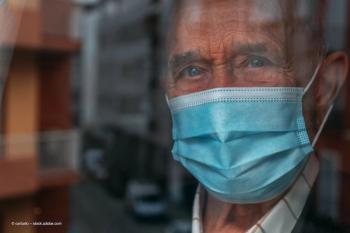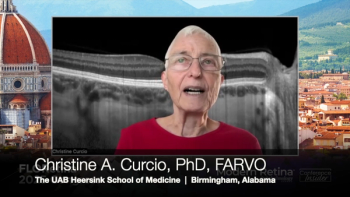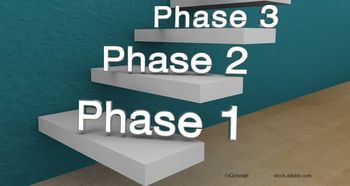
Q&A: Ashkan Abbey shares details from DAVIO-2 trial at AAO 2025
Data suggests that EYP-1901 can reduce the number of injections and treatment burden for patients
Ashkan Abbey, MD, FASRS, FAAO, from Texas Retina Associates discussed EYP-1901, an innovative intravitreal insert that releases vorolanib, a potent tyrosine kinase inhibitor designed to treat retinal vascular diseases, specifically wet age-related macular degeneration (AMD) and diabetic macular oedema (DME). The conversation highlighted 2 phase 2 clinical trials: DAVIO-2 for wet AMD and VERONA for DME. In the DAVIO-2 trial, patients previously treated with approximately 10 injections in the prior year received 3 loading doses of aflibercept, followed by either high-dose or low-dose EYP-1901 or a sham treatment.
Note: The following conversation has been lightly edited for clarity.
Ophthalmology Time Europe: You will be presenting at AAO on EYP-1901. Can you give us some highlights from that presentation?
Ashkan Abbey, MD, FASRS, FAAO: We're going to do a pretty big overview of the 2 phase 2 trials that have recently been discussed regarding EYP-1901, one was for wet AMD, and then one was for also for diabetic macular oedema. The wet AMD trial is called DAVIO-2, and the diabetic macular oedema trial is called VERONA. We'll start by just kind of addressing what exactly EYP-1901, is, which is an intravitreal insert that releases a medication known as vorolanib, which is a potent tyrosine kinase inhibitor that actually works intracellularly to bind to all 3 VEGF receptors and inhibit them, thereby increasing the vascular stability, while also not inhibiting the tie2 pathway, and therefore increasingly promoting vascular stability through that pathway as well by not interfering with it. So we're looking at something that could potentially allow us, by having a continuous dosing of this medication over the course of roughly 6 to 9 months, allow us to have a more sustained amount of treatment for our vascular diseases of the retina that maybe will reduce treatment burden, and possibly could be used also as potentially as a primary treatment in these retinal vascular disease as well, although that's going to be to be determined as we as we go along and see what the data shows, but we have some interesting signals already that there is a pretty substantial improvement in, say, diabetic macular oedema, what we saw in the VERONA trial. After just 1 injection, within 1 month of treatment, we see a really significant improvement in the anatomy and visual acuity in the patients that we were treating with DME with EYP-1901. So we do see that there is kind of this early bioavailability of the drug, even just 1 month after injection, as well, at least with the patients that we've treated in the DME trial so far.
Now that we understand kind of exactly what it is and what it's doing and what is designed for is in terms of kind of a, kind of a elongating our treatment intervals and maybe reducing treatment burden for our patients as well. The study designed for the phase 2 DAVIO-2 trial, what we'll address first, and that really was a trial that looked at patients who had been previously treated for wet AMD with, and a lot of times, on average, about 10 injections in the prior year. So they're a pretty heavily treated population. When they came into the study, they were essentially treated first with 3 loading doses of aflibercept, and then the patients were then received, would receive on that third visit, either EYP-1901 at a high dose, EYP-1901 at a lower dose, one was 3 milligrams, the other one was 2 milligrams. Or they would receive a sham, and they would just be getting every other month treatment with aflibercept. Going forward, that's 2 milligram of aflibercept. The patients were followed monthly during that time, out to roughly about a year, and the patients were looked at at a year to see if there was a significant difference in terms of change and best-corrected visual acuity among the 3 groups.
At each visit that they were seen, after those 3 loading doses, they were able to receive supplemental treatment just to based upon vision and anatomy changes. There were pre-specified criteria, and so every month, they were evaluated to see if they needed additional treatments for their disease. And what we found was that there was a substantial reduction in treatment burden, with roughly about an 85% reduction in the EYP-1901 group compared to to their prior year of treatment, and we also saw that roughly two thirds of the patients who received EYP-1901 did not require any additional supplemental treatment after receiving EYP-1901 so they want treatment, they were treatment free for the 6 months, say, after treatment.
I'm sorry just a correction: they were followed out to 6 months after treatment for their primary endpoint, and then the primary endpoint was met for the trial as well, which was essentially there was a the change in best-corrected visual acuity between the EYP-1901 groups and the sham group was not significant, so they felt they showed non-inferiority in terms of change and best-corrected visual acuity as well at that 6-month time point.
The other trial that we have phase 2 data for was actually for the indication of DME, which I mentioned earlier, which was called the VERONA trial. That trial was actually a different design, and essentially the patients came in, they were previously treated DME patients, in this case as well. They came into the trial with where they would receive just 1 injection of either a high dose of EYP-1901, which was because it was at 2.7 milligrams, or a lower dose, which was at 1.3 milligrams, or they received just 1 injection of aflibercept 2 milligrams. In that patient population, with those 3 groups that they were randomized to, then they were just followed for monthly visits over the course of 6 months to see if they needed any supplemental treatment, based upon again, pre-specified retreatment criteria that involved vision and anatomy. Again in those patients, when we followed them out to 6 months, we did see that the time to a supplemental injection was significantly increased in the patients who received EYP-1901 compared to the patients who received 2 milligram of aflibercept. And roughly two thirds of the patients who received EYP-1901 did not require any additional injections afterward, and had a substantial improvement in visual acuity and in anatomy, in terms of reduction of oedema. And then also, if you compare that to the aflibercept group, only about half of those patients were able to go supplemental injection free over the course of the study. So there was an increased number of patients who did not require any additional injections after the first EYP-1901 compared to the aflibercept group, and we had a significant reduction in in the DME that they were, that they were being treated for in the EYP-1901 group. So, you know, it was a small study, so we can't take too much from it, but it was at least showing some potential for EYP-1901 as a treatment for DME, in addition to the wet AMD data that we saw from DAVIO-2 overall, what this is leading to is that we have now completed, completely enrolled a phase 3 clinical trial, or, sorry, 2 phase 3 clinical trials, LUGANO and LUCIA, which are specifically for the treatment of wet AMD, and this included patients who are both treatment-naive and previously-treated. This has been fully enrolled now, and we're basically just continuously, continuing to monitor the patients that have been enrolled. We should have, hopefully a data readout in the next year or so from the phase 3 trials, and then maybe have a submission to the FDA after that. Then the phase 2 trial for the DME has shown that there's some promise there, and so maybe we can look forward to a phase 3 trial for DME, for EYP-1901, in the coming year or so.
OTE: We are talking AMD and DME. Are there any other indications that are being considered for this?
Abbey: Not yet, although I think it would be interesting to look at this in retinal vein occlusion patients with macular oedema from retinal vein inclusion as well, but that has not been considered yet. Maybe in the future, if they get an indication for wet AMD, they may start pursuing a new trial for maybe RVO as well. It would be interesting to see that.
OTE: Are there any other key points you'd like to add?
Abbey: Only other thing I'll add is that, you know, obviously, safety is really important in any of these new medications that we're using. There were no major significant safety signals with any of the trials that have been done with EYP-1901, there have been no cases of vasculitis, occlusive vasculitis. There have been no cases of anterior migration of the implant. It's important to also note that this, this injection, is fully eluted, the drug itself is fully eluted, completely eluded prior to the actual erosion of the implant. So what that means is that there is never going to be any free floating drug in the eye. So we have a good system here. We won't have any additional free floating drug in the eye while after the injection with EYP-1901, so overall, I think it's something that we can take a lot of comfort in the fact that we haven't seen any major safety signals with it, and it's been very well tolerated in the almost 200 patients that have received it.
OTE: Certainly, it will be interesting to see how this phase 3 data comes out, because it could a be game changer.
Abbey: I think we're really hungry now for much more durable agents than what we have now is what we can really, our clinics are being overburdened so much that if we can find an agent that we can maybe give only maybe once every 6 months, or something like that, or at the very least, even improve our ability to treat and extend our patients even more with the anti-VEGF on board, but having that in the background, I think it would be a major win for us.
Newsletter
Get the essential updates shaping the future of pharma manufacturing and compliance—subscribe today to Pharmaceutical Technology and never miss a breakthrough.







































